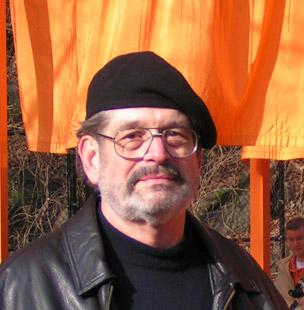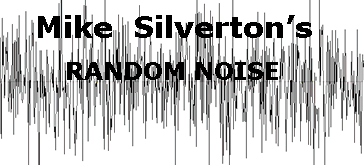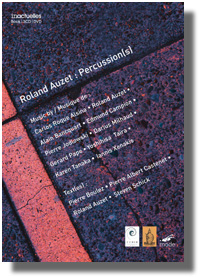Random Noise 11


Number 11
Scardanelli’s Motley visits The Stereo Times
“Would that be Philo Scardanelli, the Cubs’ first baseman back in the ’30s?”
Ha! Not even close. The German Romantic poet Friedrich Hölderlin (1770-1843) spent the latter half of his life in a tower in Tübingen in the care of a carpenter. During his long years of madness he wrote under several names, dating his work in the future and past. I borrowed the best known of these, Scardanelli, for a series of columns in LaFolia.com, of which I am publisher, editor-in-chief, chargé d’affaires, director of personnel, sergeant-at-arms, publicist, ombudsman, custodial engineer, hanger-on and janitor. Under my tutelage, Signor Scardanelli’s Motleys resemble jelly beans (but taste like Styrofoam).
So, before we get to music as other than fuel for hardware, let’s begin with a big, fat jelly bean about the much-maligned compact disc. From its inception it’s been the butt of audiophile disdain and, while it’s true that the sniping has somewhat abated, so it remains. Stereophile’s Michael Fremer has built a career bad-mouthing the medium, and Fremer’s claque, it ain’t small. One’s perception of analog saturation continues with the same publication’s Art Dudley, one of audio’s most entertaining writers, whom I can no longer read. (I don’t subscribe to TAS, so I’ve no idea what goes on there in the way of analog mania.) In the main, received wisdom has it that vinyl sounds better, as do later developments in digital sound. About higher-resolution media I’ve nothing useful to say, not yet having listened to any of it on my CD-only system. (My wife and I play DVDs in the TV room, a well attended chamber that lies beyond the scope of these remarks owing to the hardware’s no-account credentials. I sold my LPs decades ago to a shop in Manhattan that no longer exists.)
Too early one morning, when my sweet little town had yet to stir, I played a Denon CD recorded in December, 1975 by Session Director Yoshiharu Kawaguchi and Engineer Masao Hayashi in Nippon Columbia Studio No. 1. In digital sound. In 1975. The CD was released in ’85, a few years after the silver disc’s inception. (The program may first have appeared on vinyl.) The music, dating from the 1940’s, John Cage’s Sonatas and Interludes for Prepared Piano, is performed by Yuji Takahashi, who, with his sister Aki, has been a significant new-music proponent.
Since I’ve already revealed my intention to provoke, I won’t surprise anyone by praising the Denon’s fine sound. Digital. 1975. Decays tell a story. As the instrument’s ambient harmonics fade, one listens for “hash” –– some suggestion of grunge, noise, fog, whatever. The Denon’s long decays are as smooth as a baby’s buns. Superb resolution, crisp transients, the prepared piano’s clearly delineated textures, nicely sorted dynamics…. (As to the piano’s preparation, Cage set out to simulate a percussion ensemble by inserting various materials in and around the instrument’s strings.) A decay that fades to less than a whisper cleanly bespeaks superior resolution and transparency. The vinyl disc’s inherently noisy stylus-groove interactions mask these fragile traces. Digital. 1975.
(In 1972, Denon introduced the world’s first viable digital recorder. Even though the year may seem remarkably early to us, by 1975 the Japanese company had digital recording well in hand.)
I realize I’m taking a position that erodes my validity as an audiophile –– kind of like pitching pork-belly futures to the Chasidim. Who knows, I may well be the victim of impaired judgment. Hey, I may very well be deaf. Perhaps I listen to music by reading lips. Perhaps…. On the other hand (the one I prefer), as an old salt, if something were amiss, I’d have detected it.
I’ve spelled most of this out before and do again largely to forestall charges of harboring inferior gear: People whose opinions I respect place my Integris CDP (AurumAcoustics.com) among the world’s best CD playback systems. The speakers are Wilson Series 8 WATT / Puppies, about which praise amounts to redundancy. Amplification, NuForce’s Version 2 of its Reference 9 SE monos. (Because I work for NuForce, the reader is free to take a skeptical view –– but shouldn’t –– of my enthusiasm for these little beauties.) Nordost cabling throughout: Valhalla, Tyr, Brahma and Vishnu. Line conditioning begins with dedicated, high-end outlets feeding BlackNoise Modelo Extreme and Modelo 2500 line filters (classy Italian items NuForce distributes in the US). Acoustic isolation: Nordost Quasar Points under the amps and Aurum Acoustics Steel Points and a Golden Sound Pad under the CDP. Weird-but-effective-science department: from Japan, Acoustic Revive RGC-24 Virtual Ground Conditioner, RD-3 Digital Disc Demagnetizer, RIO-5 II Negative Ion Generator, and an RR-77 Ultra-Low-Frequency Pulse Generator. (For information, LotusGroupUSA.com.)
In other words, it’s an exquisitely revealing system of the good, so-so and bad –– which brings me to an Analogue Productions CD, mastered, so say the notes, from the original tapes via tube electronics by the celebrated Doug Sax. The program: Rachmaninoff’s Symphonic Dances for Orchestra and Vocalise for Orchestra, Donald Johanos conducting the Dallas Symphony, recorded in 1967 with four Charles P. Fisher ribbon mics by one of the Golden Age’s notables, David B. Hancock. Nothing stands out, lease of all the sonics, which by present-day standards are primitive. An analog treasure? Give me a break. And please don’t tell me that events spring to vibrant life in Analogue Productions’ vinyl iteration, the mention of which returns us to Stereophile and its many turntable, tone arm, phono cartridge, and tube electronics ads, along with extensive coverage of same. From my perspective here on the Steppes of Central Erewhon, methinks I espy a nostalgia virus sweeping Audiophilia. Could it be that all this quaint, gilt-edged obsolescence addresses an urgent need to which I remain a stranger? Anything’s possible.
Whatever, the music I enjoy consists for the most part of real-time, communal events: people performing in concert, or as soloists, in one coherent, and as sometimes happens, acoustically attractive space. Most studio-cobbled laminates, as slickly done as some of this stuff is, cannot create a soundstage that greets the music lover’s ear as lifelike, particularly if his or her preferences arise from live performances of unamplified acoustic instruments and voices. For most studio laminates, verisimilitude – a facsimile of live, unamplified sound – isn’t the point. Think of computerized movie effects that, exciting though they be, rarely look real.
As a timely example of a studio laminate, a recently arrived review disc, Joan Jeanrenaud / Strange Toys (TalkingHouse Records THR 0806-014A), features the former cellist of the Kronos Quartet in an innovative program of her own compositions achieved by way of “electronics and looping” and “layers of sound.” The recording rarely touches on the kind of audio I treasure. By any measure that takes resolution, transparency, harmonic subtlety and a convincingly dimensioned acoustic space into account, Jeanrenaud’s assemblages lie beyond the pale. A facsimile of real-time events has little to do with what the cellist wants to achieve. These, for me, inestimable qualities simply don’t apply to this manner of production. Soundwise, another disappointing CD? The message would be the same on whatever manner of medium.
And soon after arrived two unsolicited review CDs of stuff I don’t listen to, but content’s not the point. Both feature what has become typical studio-cobbled sound. Dreadful. And predictable. The issue becomes significant only when we stop to consider what standards and ideals a subjectivist audio reviewer applies to what he hears.
And in this corner, in the white satin trunks, a 2005 release I pulled from the shelf because I wanted to hear it again, Boulez Conducts Boulez in a program consisting ofLe Marteau sans maître and Dérive 1 & 2, with the Ensemble Intercontemporain, Pierre Boulez conducting (Deutsche Grammophon 00289 477 5327). I invite any philovinylite reading these words to tell me where this CD fails. I like the music and have the greatest respect for the composer-conductor. These 2002 IRCAM, Paris sessions fill the bill every which way. Would a higher-rez medium do it better? Maybe, but I’d be hard put to predict how. In properly done surround sound perhaps….
Are studio laminates necessarily offputting? For me almost always, but perhaps not for the listener for whom the music and sonics I cherish are an eye-crossing bore. De gustibus non est disputandum. In English, what has me reaching for the Stop button may well keep you engaged. This little screed isn’t about preferences. Discerning listeners have found the compact disc wanting. I submit that they may simply have been responding to inferior production values. And so many of them are inferior –– production values, I mean. (A question for the philovinylite: how many of the rarities you scored at garage sales sound like crap?) My 1975 digital recording demonstrates, correctly applied, that digital sound at its inception was already pretty good. I’m certain my iconoclasm will provoke cries of derision. “Who let this yahoo in?”
![]()

We turn again to my favorite recording project: John Eliot Gardiner’s direction of vocal soloists, the instrumental English Baroque Soloists, and Monteverdi Choir in Johann Sebastian Bach’s (mostly) church cantatas. In discussing earlier volumes, I mentioned that the British label, Soli Deo Gloria, came into existence soon after Deutsche Grammophon’s Archiv Produktion dropped the ball in 2000. The SDG performances have long been in the can. With respect to releases, the undertaking is due for completion in 2011. That these attractive sets have been appearing slowly doubtless addresses funding and costs. Arkivmusic.com lists the two-disc sets at $45. (I just told a fib. They’re actually $44.99.) Expensive, yes, but think about what you paid for those interconnects.
This most excellent SDG endeavor (as of this writing, fifteen two-disc and two single-disc volumes) is informed by several charming eccentricities. For example, the three recentmost volumes are numbered 27, 3, and 25, in that order. The numberings have been non-sequential from the start. I was told, and I still don’t understand, that this relates to cantata groupings around aspects of the Lutheran calendar. As to that, CD 1 of volume 25, the recentmost arrival, features three cantatas “For the Fifth Sunday after Easter (Rogate).” CD 2’s four cantatas celebrate “…the Sunday after Ascension Day (Exaudi).” Had I an interest in religion I’d want to know more. For me, it’s about the music.
Remaining with eccentricity, helter-skelter numbering comes to small change in the bright, penetrating light of what Gardiner & Co. are pleased to call a Bach Cantata Pilgrimage. Volume 14’s “For Christmas Day / For the Second Day of Christmas” performances took place on 25 December, 2000 in Manhattan’s St. Bartholomew’s Episcopal Church. This and volume 15, “For the Third Day of Christmas,” recorded in St. Bart’s on 27 December, climax a year-long peregrination among churches, abbeys, chapels, and cathedrals in Continental Europe and Great Britain. (Volumes 14 and 15 so far comprise the single-disc sets.)
Eccentricity, cont’d: The covers of these handsomely bound and printed volumes feature masterly portraits by photographer Steve McCurry of adults and children in emphatically non-Christian, non-Western dress. Given, as an educated guess, Martin Luther’s impatience with ecumenism and heathens, a generous pinch of irony flavors the portraiture. (The man was a flaming anti-Semite.)
As to what the covers enclose, Gardiner’s notes leave nothing to desire. If you need to know more, there’s always the multi-volume New Grove Dictionary of Music and Musicians. The instrumentalists of the English Baroque Soloists are as accomplished an original-instrument band as exists. The Monteverdi Choir likewise impresses. (Name notwithstanding, this is a British chorus.) From venue to venue, one vocal soloist will sometimes replace another. For example, the project’s 28 CDs feature bass soloists Nicholas Teste, Dietrich Henschel, Gerald Finley, Julian Clarkson, Peter Harvey, Stephen Loges, Thomas Guthrie, Stephen Varcoe, and Panajotis Iconomou. Several of the basses appear on more than one CD, e.g., Peter Harvey’s participation in eleven. To clear up a potential confusion, the vocal soloists never exceed four, e.g., soprano, alto (male and female), tenor, and bass.
Assorted soloists notwithstanding, I’m hard put to point to a weakness. These are accomplished performances in every way. (Old J.S. should have had it so good!) To remain with the remarkable, with respect to travel, the ensemble somewhat resembles the Road Runner cartoon character. In many instances, a few days separate setting up, rehearsing, performing and recording in unfamiliar venues. You can sometimes detect differences in acoustic properties, and yet Producer Isabella de Sabata, Balance Engineer Everett Porter, and the Polyhymnia recording team succeeded in achieving a uniformity of result far outweighing site peculiarities. And no single performance sounds other than at home!
As a casual listener, I’m familiar with a handful of the better-known cantatas. Every volume therefore features at least some music new to me. It’s been a rewarding excursion wherein I’ve discovered more delights than a poor sinner deserves. The second cantata on volume 25’s CD 2 is Nach dir, Herr, verlanget mich, BWV 150 (Bach’s BWV numbers, similar to Mozart’s K. numbers, operate as a chronological listing, not always accurately). It’s a striking work in its open, sweeping textures and heartfelt sentiments. Consulting Gardiner’s notes, I learned that this is probably Bach’s first church cantata, composed at age 20. The occasion remains unknown, but the notes do mention that Bach had to put up with less than good forces. Gardiner characterizes the music as “intriguing, if slightly experimental….” For me the experiment works. As mentioned, I’m far from being a Bach specialist. But as a music lover who’s been listening to recordings of great performers for more years than I care to think about, I know superior music-making when I hear it. These SDG sets are something special.
Time now to pay our respects to Manfred Eicher’s ECM and Brian Brandt’s mode (always lower case). Though their catalogs could not differ more, Eicher and Brandt have produced a prodigious number of releases in pursuit of their visions: these two labels fall under the “little” category only in the sense that each travels its course under one man’s direction.
Munich-based ECM is primarily a jazz label of a rather cool and laid-back complexion. Curiously enough, it’s not the huge, meticulously recorded jazz list that normally nails me to the sweet spot. My enthusiasms center on ECM’s smaller yet handsomely considered classical New Series side. It was via ECM I discovered that the Swiss virtuoso oboist Heinz Holliger is also a hugely gifted composer. In 1993, I listened in a state of astonishment to Holliger’s Scardanelli Cycle – that name! again! – for solo flute, small orchestra and mixed chorus, thanks to ECM New Series 1472/73 (two discs). In 2004 I discovered in similar fashion Holliger’s Violin Concerto, with soloist Thomas Zehetmair, the composer conducting the SWR (Südwestrundfunk) Symphony Orchestra, ECM New Series 1890. In both works Holliger contemplates the relationships of madness to artistic creation. I leave it to the reader to investigate an observation that may, in fact, have little bearing on the enjoyment of some remarkable music.
And now, in 2008, ECM New Series 2029 offers an engaging pairing: two of Haydn’s great minor-key symphonies, 39 and 45, along with Isang Yun’s 1987 Chamber Symphony I, Alexander Liebreich conducting the Munich Chamber Orchestra. I can’t say I’ve heard better performances of these Sturm-und-Drang gems. Haydn’s brilliantly innovative symphonies are grounded of course in eighteenth-century European tonalities. Soon after No. 45, nicknamed “Farewell,” subsides into nothingness, Yun’s modernist palette startles the ear. The work, for two oboes, two horns, and strings, in five contiguous movements, imparts a sense of wafting levitation. The fleeting earth is far below, and the voyage is exhilarating, its sedate and tender moments included. I’ve played this one often, and I like it better every time. Solid performance, lovely recording. A winner. (See Yun’s bio in Wikipedia for the composer’s brush with South Korea’s secret police.)
 An ECM jazz release – perhaps better classified as a closer-to-jazz-than-not – Evan Parker / Boustrophedon (in Six Furrows), features The Transatlantic Art Ensemble, fourteen players in all, including saxophonists Parker and Roscoe Mitchell, along with clarinet, flute, trumpet doubling flugelhorn, viola, violin, cello, piano, double-bass, and two percussionists.
An ECM jazz release – perhaps better classified as a closer-to-jazz-than-not – Evan Parker / Boustrophedon (in Six Furrows), features The Transatlantic Art Ensemble, fourteen players in all, including saxophonists Parker and Roscoe Mitchell, along with clarinet, flute, trumpet doubling flugelhorn, viola, violin, cello, piano, double-bass, and two percussionists.
Boustrophedon is a Greek word defined in the notes as “turning like an ox while plowing.” Thus Evan Parker’s having entitled six of the disc’s eight tracks as Furrows by way of describing the music’s melding sections. An Overture, six Furrows and a Finale comprise what impresses me each time I play this wonderful disc as a voyage across disparate terrains. Bearing in mind that the writing is never less than subtle and elegantly detailed, the music’s character shifts from serene, to introspective, to buoyant, to raucous, even to moments of slapstick humor and sentimentality, and not necessarily in that order, nor is the music consistently jazz-centric. To the contrary, and that, I think, is why I like Boustrophedon as much as I do. Its spirit and intelligence partake of two worlds: modernist classical and avant-garde jazz, which here impinge with humor and grace. Perhaps most remarkable is the ensemble’s size. The music is essentially composed, but with an improvisational feel. It’s unusual for so large a band to pull this kind of thing off as convincingly as these masterful players do. Likewise remarkable are the modest roles Parker and his co-star take. This is in no way sax-dominant music.
The Transatlantic Art Ensemble is an amalgam of British and American players. Evan Parker, a Brit, is one of music’s most distinctive free-jazz participants, as is the American Roscoe Mitchell. Mitchell’s Composition / Improvisation Nos. 1, 2 & 3, ECM 1872, was released in 2007. A superb band of soloists and roughly similar ideas about composition operate as a bridge between the two releases (as do the attractive slipcase and booklet covers), and yet one should not try to make too much of similarities.
The publicity info that came with the Mitchell disc offers a quote by the composer-performer. “Jazz is part of the whole picture, but the communication lines are all over the place now. If you’re truly in love with music, you can’t help being affected by that fact.” Bull’s-eye! “All over the place” is one thing; “all over the place” with an overlay of brilliance is something else again. Both discs feature a stretch of free-jazz anarchy uniquely padded with long, thoughtful moments bearing a resemblance to classical art music. If you’re a stranger to this world, these goings-on may take getting used to. They’re well worth the effort. I recommend both CDs with equal vigor. Dandy sonics too.
 And that brings us to Roland Auzet : Percussion(s), mode 189/92, consisting of three CDs, a double-sided DVD, and an English-French booklet of 570 pages (!). The DVD features percussionist Auzet performing Iannis Xenakis’s Psappha and Rebonds A & B, both for solo percussion. The flip-side duplication has to do with those silly zone regulations. My TV-room DVD player reads one side, the other, not.
And that brings us to Roland Auzet : Percussion(s), mode 189/92, consisting of three CDs, a double-sided DVD, and an English-French booklet of 570 pages (!). The DVD features percussionist Auzet performing Iannis Xenakis’s Psappha and Rebonds A & B, both for solo percussion. The flip-side duplication has to do with those silly zone regulations. My TV-room DVD player reads one side, the other, not.
We begin with the bad news: the set goes for $85 at arkivmusic.com. (I’m such a liar! It’s $84.99.) Now for the good news. Listen to CD 1, consisting of five works by Iannis Xenakis and one by Gerard Pape, before you check out the DVD. Xenakis (1922-2001) wrote some of the fiercest percussion music you’re likely to hear. Not loud, necessarily, so much as raw-boned and assaultive. And he was a brilliant original. That always helps. You’ll have a difficult time believing that this is one percussionist at work. Then play Jacques Goldstein’s film on DVD of Roland Auzet’s performances. You’ll become a believer as well as an admirer. (Xenakis studied architecture under Le Corbusier. The architectural category “Brutalist” certainly fits the composer’s music.)
Full coverage in a capsule review of ten composers (alphabetically, Carlos Roque Alsina, Roland Auzet, Alain Bancquart, Edmund Campion, Pierre Jodlowski, Darius Milhaud, Gerard Pape, Yoshihisa Taïra, Karen Tanaka, and Xenakis) puts your reporter’s well being at risk. The program consists of works for percussion solo, percussion and voice, percussion with instrumental ensemble, and percussion with electronics. Of all this, the most “conventional” work is Darius Milhaud’s 1952 Chamber Concerto, for marimba and nine instruments. The remainder of the program occupies the leading edge, including the only other work calling for an instrumental ensemble, Alcina’s 1974 Themen, for percussion and string orchestra. As a leading example of leading-edge aesthetics, and a personal favorite, we’ve Pierre Jodlowski’sMechano 1 and 2, for percussion and motors (Mechano 1, with drum machine;Mechano 2, with metallic machine). No few of these pieces will put your rig to the test. Yummy!
I’ll be coming back to mode soon as I recover from this motley. Check out the Web site: www.moderecords.com.

![]()
Don’t forget to bookmark us! (CTRL-SHFT-D)
Stereo Times Masthead
Publisher/Founder
Clement Perry
Editor
Dave Thomas
Senior Editors
Frank Alles, Mike Girardi, Russell Lichter, Terry London, Moreno Mitchell, Paul Szabady, Bill Wells, Mike Wright, and Stephen Yan,
Current Contributors
David Abramson, Tim Barrall, Dave Allison, Ron Cook, Lewis Dardick, John Hoffman, Dan Secula, Don Shaulis, Greg Simmons, Eric Teh, Greg Voth, Richard Willie, Ed Van Winkle, Rob Dockery, Richard Doran, and Daveed Turek
Site Management Clement Perry
Ad Designer: Martin Perry





Be the first to comment on: Random Noise 11